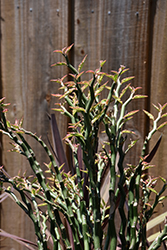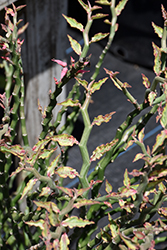Fri & Sat 8am - 8pm
Sun 8am - 7pm
Anytown, USA 12345
fax: 261.787.0463
e-mail: info@successgc.com


Plant Finder

Height: 4 feet
Spread: 3 feet
Sunlight:
![]()
![]()
Hardiness Zone: 9a
Other Names: Devils Backbone, form. Pedilanthus tithymaloides
Description:
A native of southern Florida and the Caribbean, this clump forming, succulent shrub features pointy, pink spotted green leaves on interesting, zig-zag stems; showy red bracts surround tiny scarlet flowers in late spring to early summer
Ornamental Features
Redbird Flower features showy clusters of scarlet flowers with tomato-orange bracts at the ends of the branches from late spring to early summer. The flowers are excellent for cutting. It has attractive rose-spotted green foliage with hints of yellow. The crinkled pointy leaves are highly ornamental and remain green throughout the winter. The dark green branches are extremely showy and add significant winter interest.
Landscape Attributes
Redbird Flower is a multi-stemmed evergreen shrub with an upright spreading habit of growth. Its average texture blends into the landscape, but can be balanced by one or two finer or coarser trees or shrubs for an effective composition.
This is a relatively low maintenance shrub, and usually looks its best without pruning, although it will tolerate pruning. It is a good choice for attracting bees and butterflies to your yard, but is not particularly attractive to deer who tend to leave it alone in favor of tastier treats. It has no significant negative characteristics.
Redbird Flower is recommended for the following landscape applications;
- Accent
- Mass Planting
- Rock/Alpine Gardens
- Border Edging
- General Garden Use
- Naturalizing And Woodland Gardens
- Container Planting
Planting & Growing
Redbird Flower will grow to be about 4 feet tall at maturity, with a spread of 3 feet. It has a low canopy. It grows at a medium rate, and under ideal conditions can be expected to live for approximately 10 years.
This shrub does best in full sun to partial shade. It does best in average to evenly moist conditions, but will not tolerate standing water. This plant should not require much in the way of fertilizing once established, although it may appreciate a shot of general-purpose fertilizer from time to time early in the growing season. It is not particular as to soil type or pH. It is highly tolerant of urban pollution and will even thrive in inner city environments. This species is not originally from North America, and parts of it are known to be toxic to humans and animals, so care should be exercised in planting it around children and pets. It can be propagated by cuttings.
Redbird Flower makes a fine choice for the outdoor landscape, but it is also well-suited for use in outdoor pots and containers. With its upright habit of growth, it is best suited for use as a 'thriller' in the 'spiller-thriller-filler' container combination; plant it near the center of the pot, surrounded by smaller plants and those that spill over the edges. It is even sizeable enough that it can be grown alone in a suitable container. Note that when grown in a container, it may not perform exactly as indicated on the tag - this is to be expected. Also note that when growing plants in outdoor containers and baskets, they may require more frequent waterings than they would in the yard or garden.

